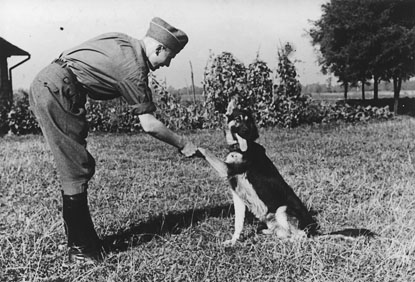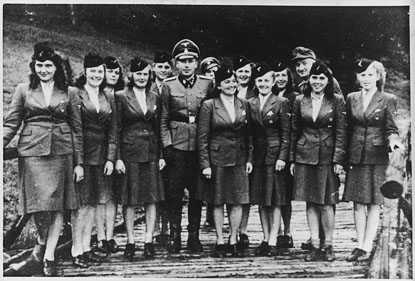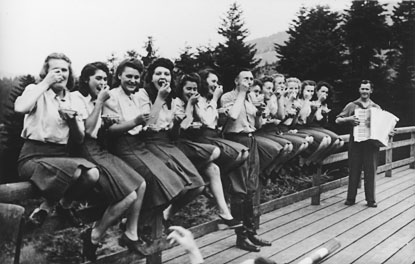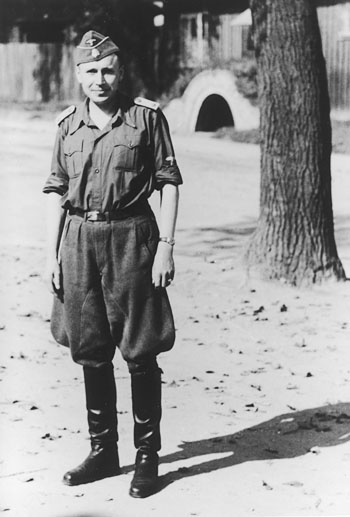
"Karl Hoecker with his dog, Favorit, Auschwitz, 1944," Photographer unknown
The man pictured above, SS-Obersturmführer Karl Hoecker, was second in command at the Nazi death camp Auschwitz, where 1.1 million Jews were murdered. The picture is from a recently-discovered photo album commemorating Hoecker's off-duty activities at Auschwitz. Most of the photos were made at Solahutte, an SS retreat just outside the camp. They cover the summer & fall of 1944, when the gas chambers & ovens at Auschwitz were operating at maximum efficiency -- systematically killing & burning arriving Hungarian Jews, then the last large group of Jews left in Europe.
I really have no adequate words for this. I'll just show you a few of the pictures

"Hoecker with Helferinnen (women's auxiliary) who have come to Solahutte for a holiday," Photographer unknown

"Hoecker eating blueberries with Helferinnen girls to music of an accordion," Photographer unknown

"Hoecker with sleeves rolled," Photographer unknown
Who was Karl Hoecker & what happened to him? This is what the U.S. Holocaust Museum's web site says:
"Karl Höcker was born in Engershausen, Germany, in December 1911, as the youngest of six children. His father, a construction worker, was killed in World War I, and his mother struggled to support the family. Höcker, who worked as a bank teller in Lubbecke, joined the SS in 1933 and the Nazi party in 1937. He married in 1937, had a daughter in 1939 and, in October 1944, a son. Upon the outbreak of war, Höcker was assigned to the Neuengamme concentration camp and spent the entire war administering various concentration camps. In 1943, he became the adjutant to the commandant at Lublin-Majdanek.
When SS-Sturmbannführer Richard Baer became the commandant of Auschwitz in May 1944, Höcker was also reassigned to the camp, again in the position of adjutant. Before he was executed for war crimes, Rudolf Höss, the most famous commandant of Auschwitz, described the role of the adjutant in his memoirs:
“The adjutant] is the first assistant to the Kommandant…He must ensure that no important event in the camp remains unknown to the Kommandant. The adjutant is the superior of all noncommissioned officers and men of the Kommandant's staff... He must ensure that no important event in the camp remains unknown to the Kommandant... The officer of the day and the first watch commander report to the adjutant, present their duty reports for this information and sign them...
Rudolf Höss. Death Dealer: The Memoirs of the SS Kommandant at Auschwitz. (New York: De Capo Press, 1996), 211-212.
Höcker remained at Auschwitz until its evacuation, and then moved with Baer in January 1945 when Baer assumed command of Dora-Mittelbau. Höcker fled before the Allies liberated the camp. British troops captured him near Hamburg in possession of identification as a combat soldier. Lacking an accurate description of him, British authorities released Höcker in 1946 after only 18 months' incarceration in a prisoner of war camp. Until West German prosecutors began looking for him in the wake of the Eichmann trial, no one came for Karl Höcker. He resumed his life in Engershausen with his wife and two children. He had turned himself in for a de-Nazification proceeding in 1952 but did not serve any time. He took up gardening in his spare time and became the chief cashier of the regional bank in Lubbecke. Though he lost his job when he was indicted in 1963 during the Frankfurt Auschwitz proceedings in 1963-1965, he was rehired in 1970 after his release from prison."
Here's more in the New York Times.
2 comments:
It's frightening how truly ordinary people can become monsters as part of an ideological "organism." These images and the description of him make him seem so benign, a small man obeying orders.
IT'S A WEDDING ALBUM--MENGELE'S DOING
Post a Comment